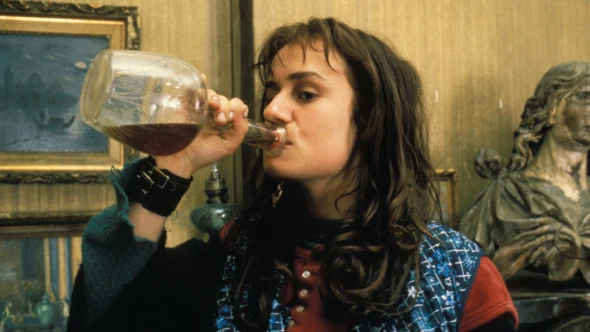
When Alfonso Cuarón set out to "reinvigorate" short-form filmmaking, he knew exactly which filmmaker to call upon: Alice Rohrwacher. The Italian writer and director was behind three features of her own: 2011's Corpo Celeste (Heavenly Body), which debuted in the Directors' Fortnight at Cannes; 2014's The Wonders, which won the festival's Grand Jury Prize; and 2018's Happy as Lazzaro, which won Best Screenplay at Cannes. With their short film, Le pupille, Rohrwacher became a first-time nominee at 95th Oscars.
"Sometimes it felt like we were making a cake, a big beautiful cake with such a degree of care," she said of the short. At the time, Rohrwacher teased that her next feature would be "a tragic but also funny story." "It's my attempt at telling a story that's about all of our selves. It's about a great sorrow, but it tries to do so in a fun way."
That film is La Chimera, a romantic drama set in the 1980s about an English tomb raider (played by Josh O'Connor) who travels the Italian countryside in search of his lost love. (The film serves as the final installment in a loose trilogy that began with The Wonders and Happy as Lazzaro.) Like all of her work, La Chimera boasts Rohrwacher's unique blend of magic realism and neorealism.
"For me, it's important to make movies that one can touch, so to speak," muses the filmmaker. "If you think about it, even in the most beautiful Etruscan vase, the most moving moment is when you find that there's an imperfection — when there is something off that tells you who the vase maker was — that is what moves us a lot more than a perfect vase would. So, on my end, I'd like to make movies that, so to speak, carry the fingerprints of us as filmmakers."
Rohrwacher says her favorite films change all the time — "every five minutes I have a new favorite list" — but here, she shares with A.frame five of the films that served as inspirations for La Chimera.

Directed by: Roberto Rossellini | Written by: Vitaliano Brancati and Roberto Rossellini
Let's start with Rossellini and Viaggio in Italia, for many reasons. There is a connection with archeology, the idea of the travel through this country and the fact of how the landscape impacts the relationship of this couple. Their communication does not go through words, but it goes through the landscape that they are going through.

Directed by: Federico Fellini | Written by: Federico Fellini and Bernardino Zapponi
Of course, I need to put in a Fellini movie. Fellini's Roma is deeply evoked in this film, because that is a mosaic film around a theme, which is the city of Rome. And this came to my mind very often because I love this movie very much, and also because many of the tombaroli — the grave robbers — that I interviewed, would tell me about this experience of entering into an Etruscan grave that was intact. All of a sudden, they would see that the objects and the drawings would disappear in front of them, because when oxygen came in, the contact with oxygen made them disappear. This is a scene that Fellini told very well in his movie Roma. Therefore, I felt him very close to me, because I imagined that Fellini must have had some tombaroli friends.

Directed by: Marcello Fondato | Written by: Marcello Fondato, Francesco Scardamaglia, Vicente Coello, and Jesús R. Folgar
There's a vibe to it which is sort of like commedia all'italiana to some extent. There's a moment in this movie when Bud Spencer and Terence Hill step into a bar to go look for some bad guys, and all of a sudden they end up on a boat in the middle of the ocean and that's when all their fighting happens. We thought about this film quite a bit when we imagined the scene of the tombaroli needing to end up in the middle of a lake in Switzerland. It seemed very difficult to pull off — how would the tombaroli arrive in the middle of the lake without explaining how they would get there? — so I said to my team, "Well, if Bud Spencer and Terence Hill pulled it off, we can do it too!"

Written and Directed by: Agnès Varda
Sans toit ni loi — in English, Vagabond — is a movie about destiny. There's an unpleasant and ugly character, but it conveyed to me a very, very strong feeling of not being able to enter into this character. One cannot identify with this character. I certainly couldn't. Yet at the same time, I felt a lot of pain for him. I felt a lot of compassion, for example, when he died, even though it's a character that does anything they can not to be loved. Well, at the end, in spite of everything, I loved him. And so, in Varda's character, there's a way of following what happens in terms of this character's destiny.
It's a tragic destiny and one cannot walk away from it. That is almost like a Way of the Cross, which is very familiar to the Italian tradition where you see the different steps that a character has to go through before they get to their destination.

Written and Directed by: Pier Paolo Pasolini
During shooting, we all got together as a team and we watched other movies. Accattone is a movie that was helpful for us for for Arthur's character. We also watched The Misfits by John Huston for Italia's character. And then [Sergei] Parajanov's movies are pure poetry. I think I should go towards a pure poetry movie and that would be Parajanov and Pasolini — movies that give the role of conveying poetry to images.






